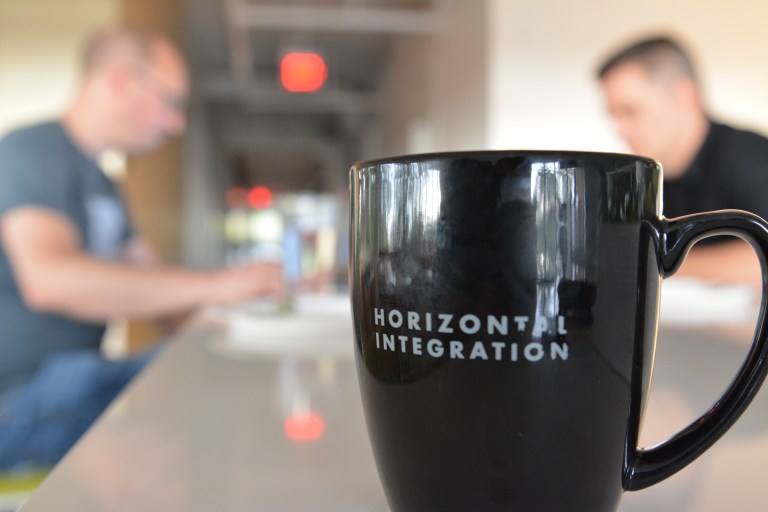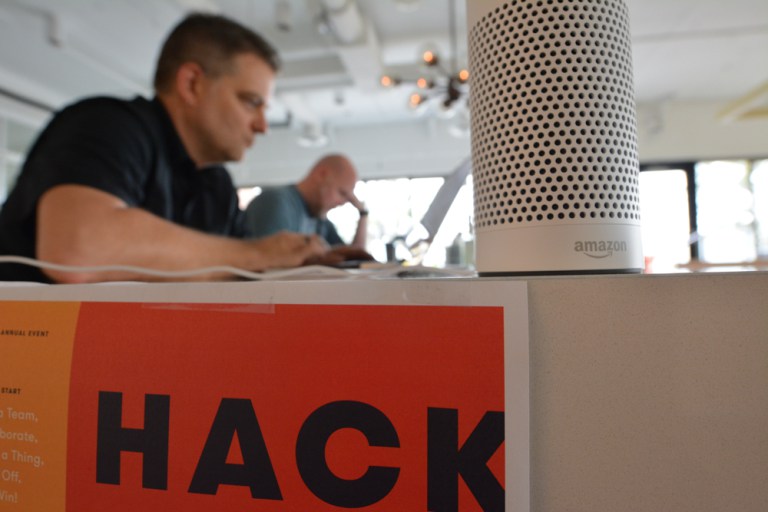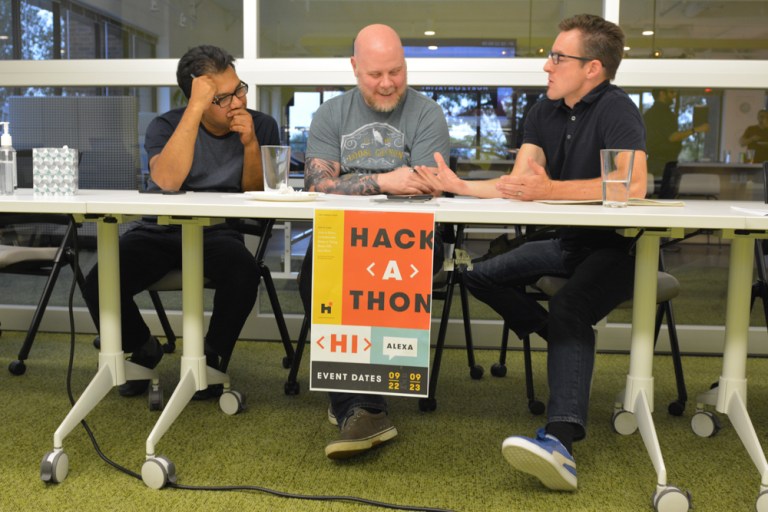Sitecore for Developers
Let's Have a Hackathon

The word Hackathon tends to conjure images of disheveled, be-spectacled groups of people chugging Red Bull and typing furiously while discarded post-it notes and whiteboard markers litter the room. Hackathons are all the rage, building excitement among techies that the next big idea is theirs and only one fun, fast-paced weekend away.If the above sounds cynical, it’s not, and it’s surprisingly accurate. We recently hosted a Hackathon of our own, and it was so fun. Participants took over the agency, leaving trails of diet Coke cans, cold coffee, half-eaten sandwiches, and tangled computer chargers in their wake.

How We Hack
Our Hackathon worked the same way most Hackathons work: it was a design sprint-like event in which people from all the disciplines at HI (development, design, strategy, project management, QA, etc.) spent a couple of days together collaborating intensively on a software project.The ingredients:
- 1 challenge
- unlimited caffeine
- 24(ish) hours
- Pizza and more pizza
- 14 participants
- 2 dozen bages
- 3 Alexa devices
- 1 keg of beer
- 3 Powerpoint decks
- 1 winner to rule them all
Why We Hack
We are a digital agency and our clients are varied. Most days we are heads-down, working hard to deliver on our many projects. The Hackathon was conceived of as a way to stimulate new ideas, cultivate collaboration, encourage exploration, and develop new capabilities within the agency. It additionally gave participants the opportunity to work with different team members and better understand how other disciplines think. We believe that setting aside time and space to play helps us continue to be the thought leaders our clients have come to rely on.The goal for this Hackathon was to quickly translate innovative ideas into functional proofs-of-concept that have some relevance to the types of clients and industries we work with. This meant asking participants to think outside the box about how we serve our clients and translate our blue-sky ideas into real-life business cases.
A Dose Of Healthy Competition
We’re a collaborative, friendly agency, but there’s nothing wrong with a good-natured contest! Sure, everyone’s a winner, but only one team would come away with sweet prizes and unlimited bragging rights.How to play:
- Make a team
- Build a thing
- Present a thing
How to win:
- Most Innovative: How original is the idea and does it innovatively utilize the underlying technologies?
- Most Functional: Does the prototype function as described and adhere to user experience conventions?
- Best Presentation: Was the team able to explain their idea and how it works?
- Most Relevant: Does the prototype accomplish the goal(s) of the Hackathon and can it be pitched to clients?
Three teams signed up to spend a Friday evening and a full Saturday hacking. Presentations occurred Saturday evening, with the winner chosen according to the criteria above.
And the challenge was……to build an Alexa skill!

We’re in the business of creating websites (shout-out to Sitecore) but we remain ever aware that technology is constantly changing, integrating, and moving in different directions. Seemingly born each day is a new way for businesses to reach customers, and Alexa has great potential in untapped markets. Part of our job is educating our clients on these opportunities and helping execute robust engagement plans that supplement or drive traffic to the online experiences we create.
What is Alexa?
Alexa is one of many voice assistants competing for users in the emerging space of voice interaction and AI. This technology has evolved over many, many years (digital speech recognition was first unveiled in 1961) but many businesses have had difficulty finding practical applications. Now, with devices like Amazon Echo, Apple Homepod, and Google Home, the public seems to be coming around and finding value in voice interaction. The platform and hardware are there. Are businesses keeping up?
Alexa enables users to search online ??, find information on products ?, ask questions?, get directions ?, play music ?, check travel and weather information ? ?, set alarms ?, get the news ?, operate smart home devices ?and more, all with their voice ?. There is so much opportunity here for companies and brands to connect with their customers on this casual, convenient, and conversational platform.
In essence, voice interaction removes barriers between users and their goals. There’s no need to find the right app, to tap into menus or type commands. Users just think, speak, and let Alexa do the rest. However, there is an incredible amount of research and planning needed to make an Alexa skill successful and valuable. There are more than 25,000 skills in the Alexa store, most of which have 0 or 1 star reviews. Retention of users is worse than smartphone apps. Clearly, there is a significant gap between what Alexa is capable of and what users want. This Hackathon helped us bridge that gap to discover when and how voice interaction can work towards business goals and make users happy.
What is a skill?
Think of a skill to Alexa as an app an iPhone. Skills broaden Alexa’s capabilities and help personalize the device to the user. They allow companies to plug into the platform and leverage voice interaction to serve users with content, products, or services.Skills incorporate automatic learning to seamlessly provide personalized information to users. Skills can perform a variety of utilities and typically fall into one of four categories:
- Doing: Performs a task. “Alexa, add milk to my grocery list.”
- Searching: Identifies specific information. “Alexa, what is the weather like today?”
- Telling: Provides a quick reference point. “Alexa, tell me a fact about cats.”
- Browsing: Gives information on a broad subject. “Alexa, ask Amazon what is on sale.”
Triggering a skill boils down to two parts:Invocation (name of the skill) + Intent (unique thing that the skill is able to do).Skills start with a core functionality and expand capabilities and features over time. For the purpose of our Hackathon, participants would focus on a core functionality and lay out how the skill could be innovated upon and evolve over time.
Let's Hack
Three teams got to work on a Friday evening, surrounded by laptops and pizza. In just 24 hours, presentations were set to begin.
Identifying Purpose & Context
The teams first needed to decide what they were going to build and how it would align with the judging criteria. To create a prototype that truly solved a problem for a user, teams needed to identify:
- What is the purpose of the skill? Why will people want to use it?
- What will the person be doing before, during, and after interacting with the skill?
- What will people get from the skill that they cannot get another way?
Identifying Capabilities & User Stories
With the core idea of the skill in place, teams next identified the scope and how it would work:
- What can a user do, or not do, with the skill?
- What information is the person expected to have available?
- What are the ways a user can invoke the skill?
- What features directly support the purpose?
Creating Interaction Models, Flows, & Scripts
To move into development, teams needed to create tangible artifacts that would map out how the skill works from a technology standpoint. This meant outlining:
- Specific invocations, intents, and utterances (what people can say)
- The shortest route to completion (happy path)
- Branching logic (decision trees and alternate paths)
- System logic (behind-the-scenes decisions)
- Integrations, if needed (account linking, APIs, etc.)
- Error states and edge cases
- Script (what Alexa says and when)
Code, Test, Code
Once the groundwork was laid, developers got to work building the skill, testing interactions, plugging into Amazon’s developer portal, and discovering what worked and what didn’t.
The Moment of Truth
Saturday evening rolled around and presentations were imminent. There was a pizza delivery, again. Teams hurriedly tested their demos and put final touches on their presentations.The panel of three judges included:
- Sabin Ephrem, Founder/President and CEO at Horizontal Integration
- Matt Fairchild, VP of Technology at Horizontal Integration
- Todd Serger, Creative Director at SapientRazorfish

First up, Team J/K presented Restaurant Roulette. The skill allowed the user to specify a location and two factors (food type and top rated, for example) and have Alexa provide a restaurant recommendation.Next, Team Voltron presented GoJIRA, a skill that would allow users to access and move Jira tickets with simple voice commands.Finally, Team Baby Got Hack presented Check My Hearing. The skill was designed with a specific client in mind and would allow a user to take a preliminary hearing test using audio files through Alexa.
…and the winner was
Check My Hearing pulled ahead to take first place, followed by GoJIRA in second, and Restaurant Roulette in third.
What We Learned
With nearly every discipline at HI represented on team Baby Got Hack, it came as no surprise that Check My Hearing won the Hackathon. The other teams were both smaller and lacking in discipline diversity. We learned how important team balance is in a fast-paced, innovation-driven environment. While a Hackathon is often thought of as a development-focused event, the end result can be greatly enhanced through collaboration and contributions across digital disciplines. The fact is, ideas can come from anywhere. A team is strongest with diverse skillsets and points of view, which is a perspective we bring to client projects daily.

The Future of Voice
Voice is here to stay, and HI is ready to tackle these projects. Smart speakers are being used across generations and reside in an ecosystem that is agnostic of device. The rapid adoption of this technology indicates a desire among users to reap the benefits of technology without the learning curve that comes with limiting visual interfaces.For brands interested in leveraging voice interaction, the proposition of being able to talk directly to a captive audience is almost too good to be true. There is no denying that this technology will continue to evolve to better serve users in the same way websites and apps have improved by leaps and bounds to do the same. Sound intriguing? Let HI help you discover how to leverage voice interaction technology as a part of your brand. Sources
- Jeffrey Isham & Meng Thao’s Hackathon kickoff deck
- https://medium.com/swlh/the-past-present-and-future-of-speech-recognition-technology-cf13c179aaf
- https://www.tomsguide.com/us/pictures-story/806-best-alexa-skills.html#s1
- https://chatbotsmagazine.com/a-short-history-of-voice-assistants-with-alexa-c322824efb7a
- https://en.wikipedia.org/wiki/Virtual_assistant_(artificial_intelligence)
- https://developer.amazon.com/alexa-skills-kit